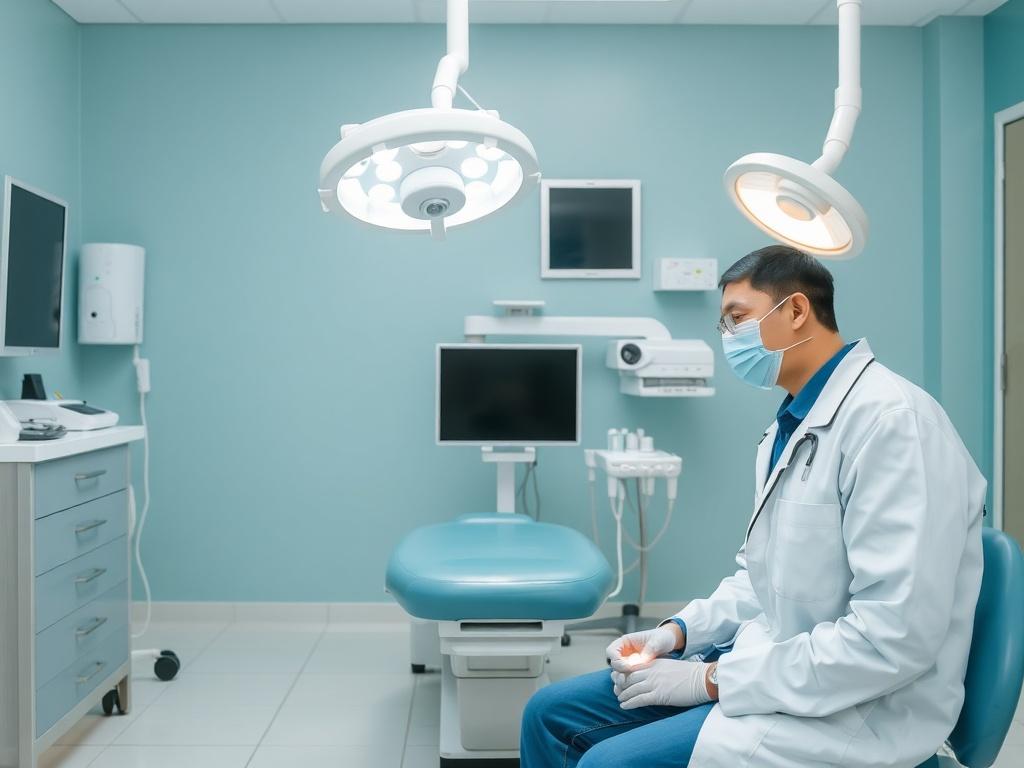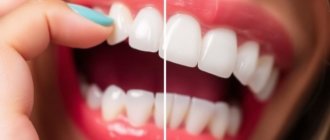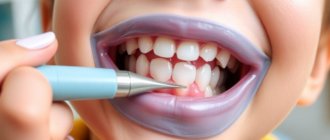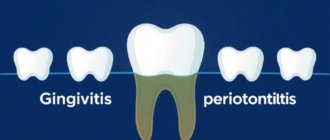Dental pain or trauma can strike unexpectedly, and knowing whether to rush to the emergency room (ER) or make an urgent appointment with your dentist can be confusing. Many people find themselves unsure of what constitutes a real dental emergency and where to go for the best care. In this article, we will explore the crucial question of when to visit the ER vs. the dentist, helping you make informed decisions when faced with toothaches, injuries, or other dental issues.
Understanding the difference between the services provided by emergency rooms and dentists is the first step. The ER generally handles severe injuries or situations that involve life-threatening conditions, such as jaw fractures or uncontrollable bleeding. On the other hand, dentists specialize in diagnosing and treating dental problems like infections, tooth pain, or broken teeth. This article breaks down various scenarios, symptoms, and treatments to guide you on the best course of action.
Содержание
What Counts as a Dental Emergency?
Before diving into comparisons between the ER and dentists, let’s clarify what qualifies as a dental emergency. Sometimes, the line between a non-urgent dental issue and a true emergency can be blurry. Still, identifying symptoms that require immediate attention is crucial to avoid worsening conditions or permanent damage.
Dental emergencies often involve:
- Severe tooth pain or swelling
- Knocked-out teeth
- Serious mouth or facial trauma
- Uncontrolled bleeding in the mouth
- Abscess or infection with fever and swelling
- Broken or cracked teeth causing intense pain
By understanding these conditions, you can better recognize whether visiting the ER vs. the dentist is appropriate.
Common Symptoms and What They Mean
Many people think every toothache or broken tooth means they should rush to an ER, but that’s not always necessary. Let’s look at the common symptoms you might experience and what they typically indicate.
| Symptom | Possible Cause | Recommended Action |
|---|---|---|
| Severe, persistent toothache | Infection, abscess, cavity | Visit your dentist promptly |
| Tooth knocked out completely | Trauma, injury | Urgent dental care; ER if severe bleeding or other injuries |
| Swelling in face or gums with fever | Oral infection or abscess | ER if swelling obstructs breathing; otherwise dentist |
| Cracked or broken tooth | Accident, biting hard object | See dentist quickly; ER if severe bleeding occurs |
| Heavy bleeding from mouth | Trauma, injury | Go to ER immediately |
| Jaw fracture or dislocation | Severe trauma or accident | ER first, then dental follow-up |
Why Choose the Emergency Room?
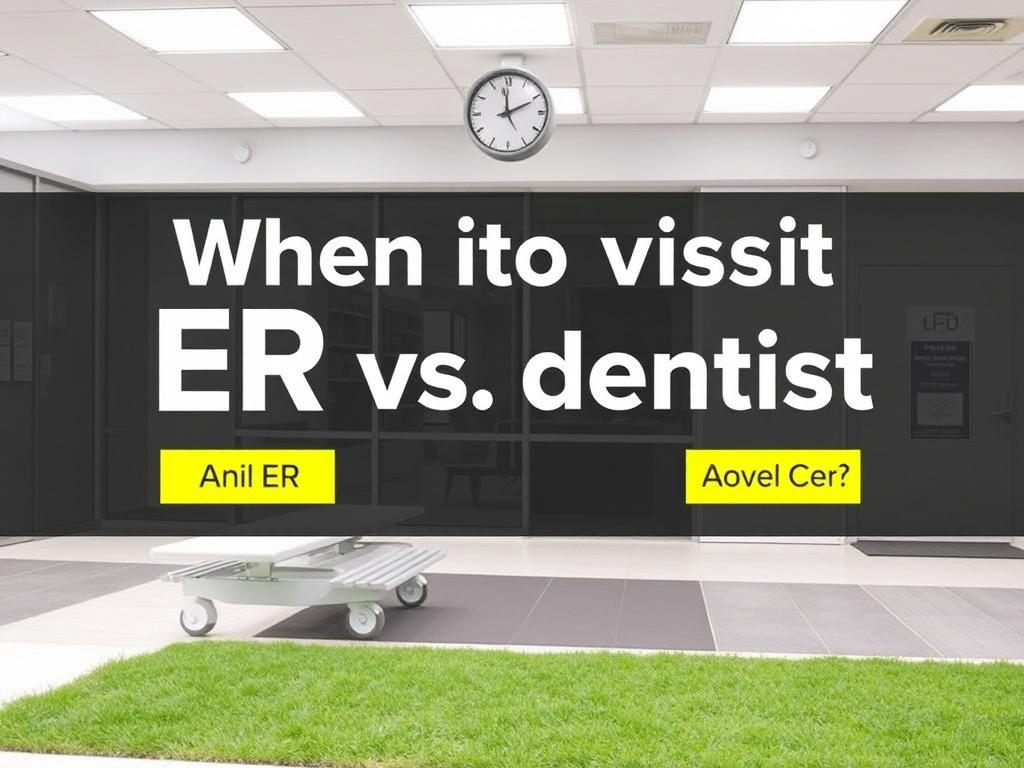
The emergency room is designed to handle urgent medical situations that could endanger your life or cause significant harm if left untreated. Although the ER can manage some dental problems, it’s important to understand that emergency rooms do not have dental specialists on staff. They mainly focus on managing pain, controlling bleeding, and addressing life-threatening complications.
When ER Visits Are Necessary for Dental Issues
You should visit the ER if your dental issue involves:
- Severe trauma from an accident, such as a car crash or a serious fall, causing broken jawbones or facial fractures
- Uncontrollable bleeding that doesn’t stop with direct pressure
- Difficulty breathing or swallowing due to severe swelling in the mouth or throat
- Severe infections spreading to the face or neck, especially if accompanied by fever and chills
- Loss of consciousness or other symptoms linked with major head injuries during dental trauma
In these cases, the ER can stabilize your condition and manage immediate risks. Once the life-threatening issue is addressed, they will refer you to a specialist, such as an oral surgeon or dentist, for further treatment.
What to Expect at the Emergency Room
When you arrive at the ER with a dental problem, doctors will typically carry out an initial exam focused on urgent needs. They might take X-rays, clean the wound, or provide pain relief and antibiotics. However, because emergency doctors are not dental specialists, they usually don’t perform definitive dental treatments like root canals or tooth extractions during your ER visit.
The goal of an ER visit for a dental issue is often to manage urgent symptoms and prevent complications until you can see your dentist or an oral surgeon. It’s important to follow-up after your ER visit to ensure your dental problem is properly treated.
When Should You See a Dentist in an Emergency?
Dentists are the best choice for most dental emergencies. They are trained to diagnose and treat both common and complex dental problems. Knowing when to visit a dentist rather than the ER can save you time, money, and may lead to a better outcome for your oral health.
Dental Emergencies Best Handled by Your Dentist
If your issue involves any of the following, calling or visiting your dentist is usually the best course of action:
- Severe but localized tooth pain without trauma
- Loose fillings or crowns causing discomfort
- Swollen gums or abscess limited to the mouth
- Sensitivity to hot or cold lasting more than a day
- Objects stuck between teeth causing pain or discomfort
<li<Broken or cracked teeth without heavy bleeding
Your dentist will be able to provide targeted treatments such as fillings, root canals, or antibiotics for infections. If necessary, they can refer you to a specialist for emergencies that require more advanced care.
Tips for Visiting Your Dentist During Emergencies
Many dental offices now offer after-hours emergency services. When you call your dental office, explain the situation clearly and mention if you experienced trauma or excessive swelling. If the office can’t see you immediately, they may provide advice to manage pain or swelling until your appointment.
It’s also a good idea to keep your dentist’s contact information handy and know the location of the nearest urgent dental care clinic. These clinics specialize in dental emergencies and operate during evenings and weekends when regular offices might be closed.
Common Scenarios: ER vs. Dentist
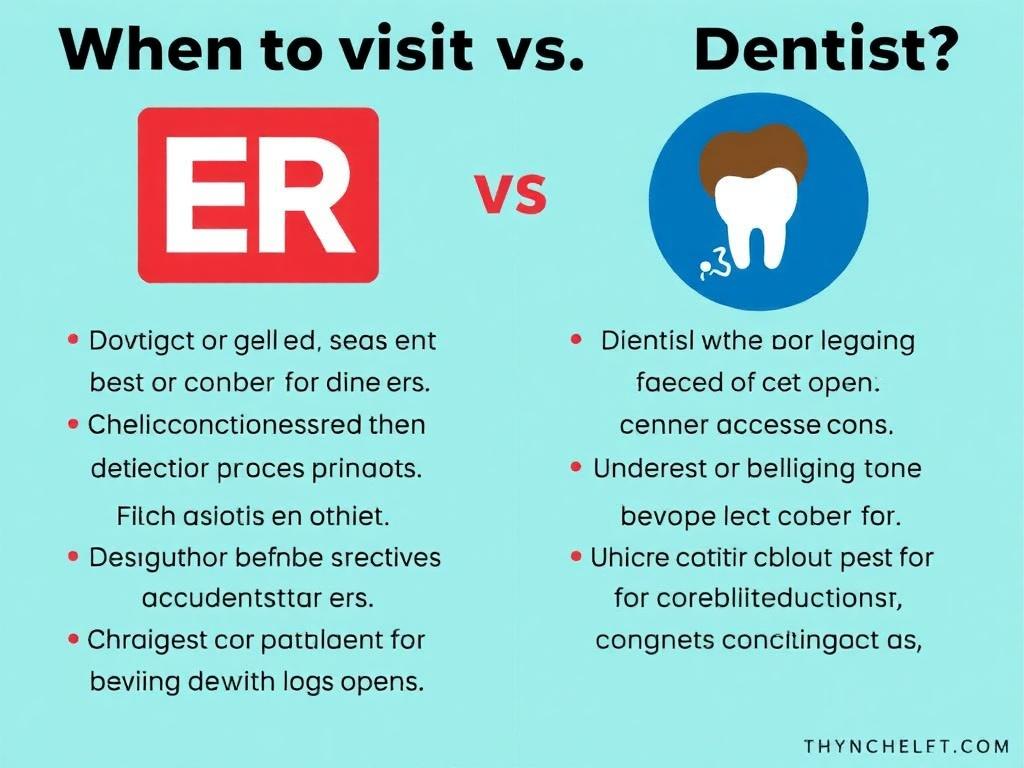
To make the distinctions clearer, let’s explore some common dental emergency scenarios and discuss when you should go to the ER vs. the dentist.
Scenario 1: Knocked-Out Tooth
Imagine you’re playing sports and get hit in the mouth, knocking out a tooth. This is a true emergency that requires quick action. If there is no serious bleeding or facial trauma, immediately try to preserve the tooth by rinsing it gently and storing it in milk or saliva. Call your dentist or go to an urgent dental clinic as soon as possible.
However, if the accident also caused significant facial swelling, uncontrollable bleeding, or jaw injuries, heading to the ER first for stabilization is the best option.
Scenario 2: Severe Toothache with Swelling
A toothache that worsens over days and is accompanied by swelling is likely a sign of infection or abscess. Since infections can spread quickly, timely dental treatment is essential. Unless the swelling blocks your airway or there are signs of systemic infection (fever, chills, difficulty breathing), the dentist is the best place for care.
Scenario 3: Broken Tooth After a Fall
If you fall and chip or crack a tooth but bleeding is controlled and the pain is manageable, seeing your dentist quickly is the right choice. If there is heavy bleeding, facial fractures, or jaw pain, head to the ER first.
Scenario 4: Uncontrollable Bleeding From the Mouth
This is a clear sign you need emergency medical care at the ER. Heavy bleeding could result from trauma, injury to blood vessels, or post-surgical complications and requires professional management to stop blood loss and prevent shock.
Scenario 5: Jaw Pain with Difficulty Moving the Mouth
Jaw injuries, like fractures or dislocations, often need immediate ER care due to the potential for airway obstruction or damage to vital structures. Once stabilized, repair and longer-term dental or surgical treatment can proceed.
How to Prepare for Dental Emergencies
Nobody wants to face a dental emergency unprepared. Taking a few preventive steps can reduce the stress if one occurs.
Keep a Dental Emergency Kit
assembling a small kit with essential items can be a lifesaver:
- Clean cloth or gauze for bleeding
- Containers for storing knocked-out teeth
- Over-the-counter pain relievers
- Contact information for your dentist and nearest emergency care
- Saline solution or milk for preserving teeth
Regular Dental Check-Ups Help Prevent Emergencies
Routine dental visits catch problems early and reduce the risk of sudden emergencies like infections or tooth fractures. Maintaining good oral hygiene is another crucial way to prevent crises.
Know Your Options
Identify urgent dental clinics near you that offer after-hours care. It’s helpful so you know where to go if you cannot reach your regular dentist, and your dental insurer might cover certain emergency visits.
Understanding Costs: ER vs. Dentist
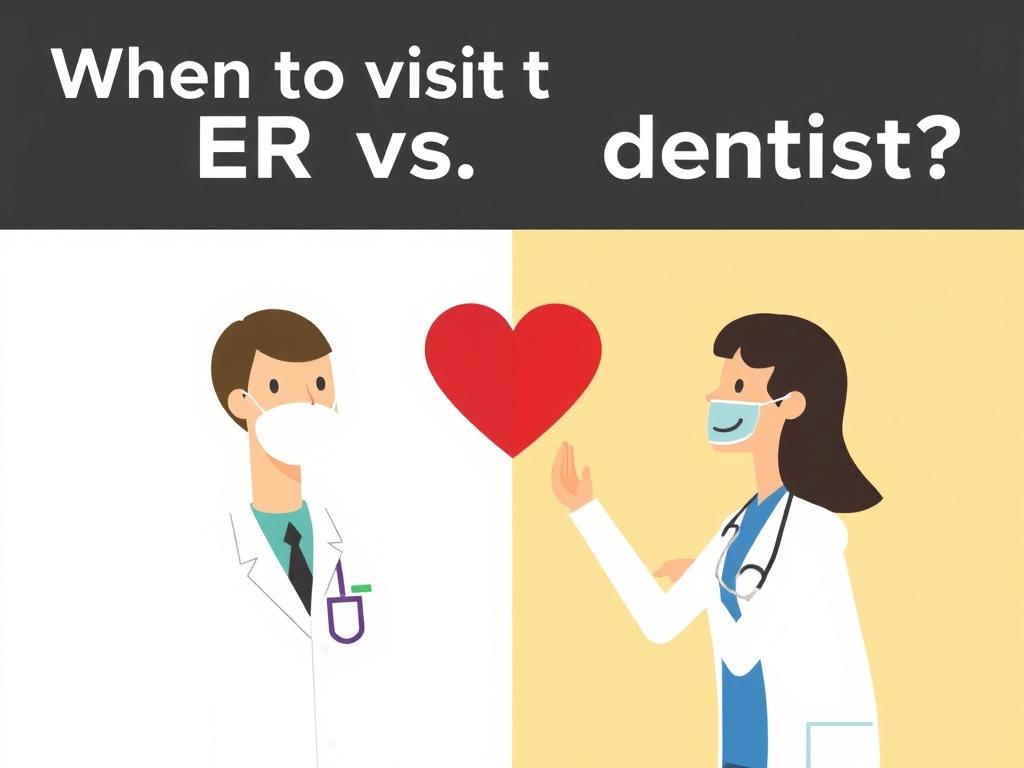
Choosing between the ER and the dentist can also have financial implications.
Cost Differences
| Type of Visit | Typical Cost Range | Services Provided |
|---|---|---|
| Emergency Room Visit | $500 – $3,000+ | Medical stabilization, pain management, initial imaging |
| Urgent Dentist or Dental Clinic | $100 – $800 | Dental repair, root canals, extractions, antibiotics |
ER visits are often much more expensive due to the overhead and medical resources involved. Some insurance plans also cover dental emergencies differently from medical emergencies. A dental emergency best treated by your dentist may save you money and provide better-focused care.
When in Doubt, Call Your Dental Office or Medical Provider
If you experience dental pain or trauma and feel unsure whether to rush to the ER or dentist, your first step should be to contact your dental office or your primary care provider. Often, explaining your symptoms can help them guide you on the right decision.
Some dental offices have emergency hotlines, and many medical providers can offer advice over the phone. Remember, delaying treatment during severe emergencies may worsen outcomes, so never hesitate to seek care if you’re in doubt.
Summary of Key Points
- Visit the ER for serious trauma, uncontrollable bleeding, difficulty breathing, or jaw fractures.
- See a dentist promptly for toothaches, infections, broken teeth without heavy bleeding, and abscesses.
- Keep important contact numbers handy and assemble a dental emergency kit.
- Understand that ER visits are costly and generally focused on stabilization, while dentists provide definitive care.
Conclusion
Deciding when to visit the ER vs. the dentist in a dental emergency can feel confusing, but knowing the differences in care can help you respond correctly and swiftly. The emergency room is essential for life-threatening situations involving severe trauma, uncontrollable bleeding, or airway obstruction. Meanwhile, your dentist is the best resource for most dental emergencies involving pain, infections, or tooth damage without systemic symptoms. Preparing ahead with a dental emergency kit, knowing your nearest urgent dental providers, and maintaining regular dental checkups can prevent many emergencies and help you take control if one arises. Ultimately, timely care tailored to your situation leads to the best outcomes for your oral health and overall wellbeing.

